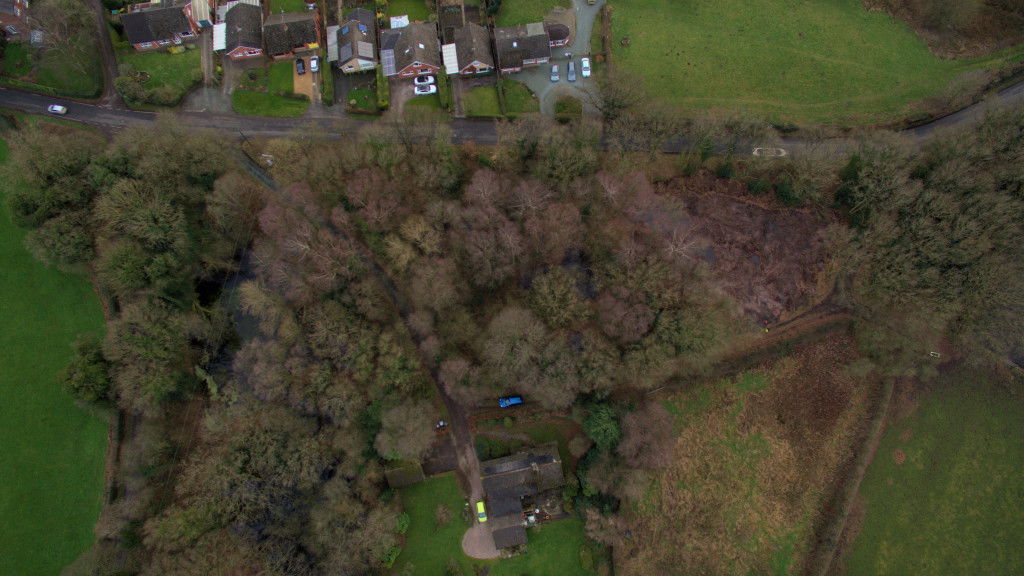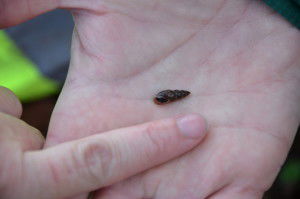PondNet finds Mud Snail safe on Sound
2nd February 2016
Sound Common is a precious pocket of lowland heath in the Cheshire countryside and, thanks to PondNet volunteers, we know it is still home to the rare Mud Snail too
 An aerial view of part of Sound Common by Simon Stickland
An aerial view of part of Sound Common by Simon Stickland
Peppered with ponds, the site has a varied history. In the past it was a perfect place for Mud Snail, but the increasing tree cover squeezed out not only the heathland vegetation but the Mud Snail (Omphiscola glabra) too.
 The Mud Snail found by Amanda Barber and Simon Stickland in January 2016
The Mud Snail found by Amanda Barber and Simon Stickland in January 2016
Last seen in the early 1990s when we surveyed the site for the National Pond Survey, and not looked for since, the record of Mud Snail at the site was thought to be an error in local records. But a PondNet survey in 2013 confirmed Mud Snails were still present, and PondNet volunteers Amanda Barber and Simon Stickland found another specimen this January, supporting our selection of the common as a Flagship Pond site.
 PondNet volunteers Amanda Barber and Simon Stickland with the Mud Snail they found
PondNet volunteers Amanda Barber and Simon Stickland with the Mud Snail they found
Changes over the decades mean many ponds are no longer suitable for Mud Snail. Thankfully, Cheshire East Council and Natural England are working to reinstate more open heathland habitats, and that’s going to help the Mud Snail too. Support from the Flagship Pond project will help look after the one remaining Mud Snail pond, and potentially restore another pond to strengthen the snail population.
 The temporary pond in September 2015, carpeted in Water Violet
The temporary pond in September 2015, carpeted in Water Violet
The snail lives in a temporary pond that is also home to Great Crested Newts and the lovely Water Violet. Temporary ponds like this are often overlooked, assumed to have little value. But these habitats are in fact very special, many of them home to a range of rare and interesting species that aren’t found in permanent ponds. Many temporary ponds and their special inhabitants are lost through drainage or deepening to make permanent ponds.
 The Mud Snail is a rare and declining wetland mollusc. Historically, it was widespread throughout lowland areas of England and Wales. Although possibly under-recorded, it is thought that this species has undergone a marked decline in the last 50 years and it is now classified as Vulnerable. Mud Snails are typically found in clean, nutrient poor waters including freshwater marshes, amongst shallowly flooded tussocks of purple moor grass, small ditches, temporary pools or seepages and track-ruts. These habitats partially or completely dry up in summer, and the snails burrow into the exposed soft mud and become dormant.
The Mud Snail is a rare and declining wetland mollusc. Historically, it was widespread throughout lowland areas of England and Wales. Although possibly under-recorded, it is thought that this species has undergone a marked decline in the last 50 years and it is now classified as Vulnerable. Mud Snails are typically found in clean, nutrient poor waters including freshwater marshes, amongst shallowly flooded tussocks of purple moor grass, small ditches, temporary pools or seepages and track-ruts. These habitats partially or completely dry up in summer, and the snails burrow into the exposed soft mud and become dormant.
 Water Violet at Sound Common – it enjoys seasonal drying out of ponds but cannot survive permanent drainage
Water Violet at Sound Common – it enjoys seasonal drying out of ponds but cannot survive permanent drainage
PondNet volunteers will continue to monitor the Mud Snail population on Sound Common, to help detect trends in pond quality and pond species across the country. We also hope local volunteers will help us carry out further surveys across the site and wider area, because Mud Snail might just be present elsewhere.
What next?
- Read about PondNet and sign up for a survey square
- Find out more about Flagship Ponds
- Take a look at other ways you can support our work
- Join our mailing list to receive our monthly newsletter and more
- Join us on Facebook and Twitter to hear more about freshwater wildlife
